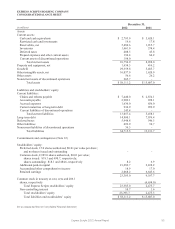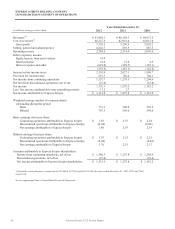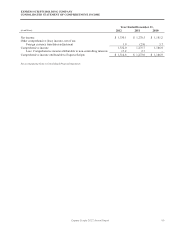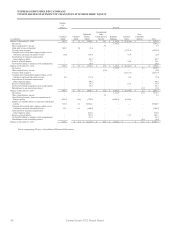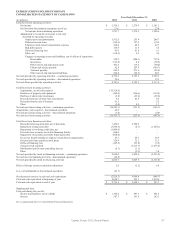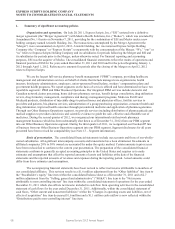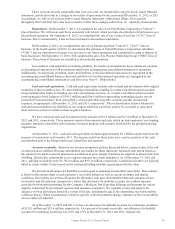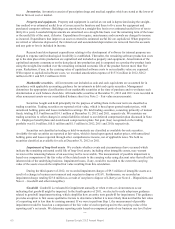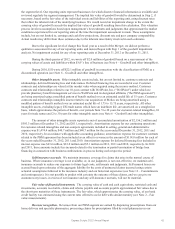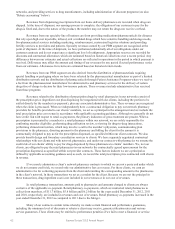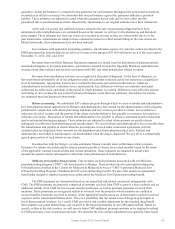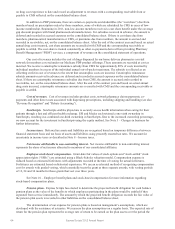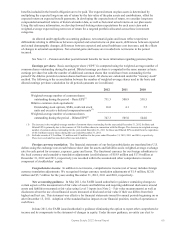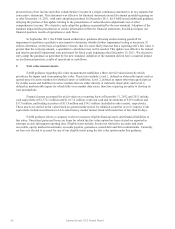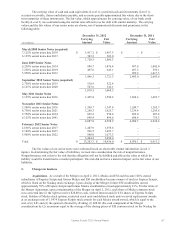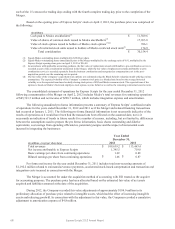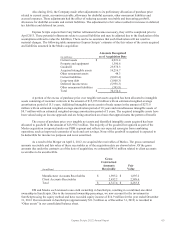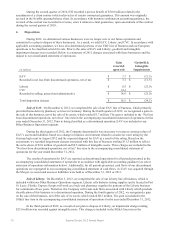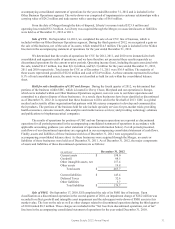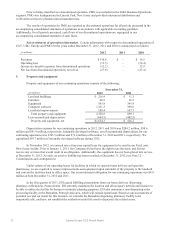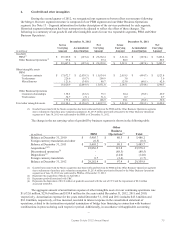Express Scripts 2012 Annual Report Download - page 65
Download and view the complete annual report
Please find page 65 of the 2012 Express Scripts annual report below. You can navigate through the pages in the report by either clicking on the pages listed below, or by using the keyword search tool below to find specific information within the annual report.
Express Scripts 2012 Annual Report 63
guarantee. Actual performance is compared to the guarantee for each measure throughout the period and accruals are
recorded as an offset to revenue if we determine that our performance against the guarantee indicates a potential
liability. These estimates are adjusted to actual when the guarantee period ends and we have either met the
guaranteed rate or paid amounts to clients. Historically, adjustments to our original estimates have been immaterial.
At the end of a period, any unbilled revenues related to the sale of prescription drugs that have been
adjudicated with retail pharmacies are estimated based on the amount we will pay to the pharmacies and historical
gross margin. Those amounts due from our clients are recorded as revenue as they are contractually due to us for
past transactions. Adjustments are made to these estimated revenues to reflect actual billings at the time clients are
billed; historically, these adjustments have not been material.
In accordance with applicable accounting guidance, amortization expense for customer contracts related to the
PBM agreement has been included as an offset to revenue in the amount of $114.0 million for each of the years ended
December 31, 2012, 2011 and 2010.
Revenues from our Other Business Operations segment are earned from the distribution of pharmaceuticals
and medical supplies to providers and clinics, performance-oriented fees paid by Specialty Pharmacy manufacturers,
revenues from data analytics and research associated with UBC and other non-product related revenues.
Revenues from distribution activities are recognized at the point of shipment. At the time of shipment, we
have performed substantially all of our obligations under our customer contracts and do not experience a significant
level of reshipments. Appropriate reserves are recorded for discounts and contractual allowances, which are
estimated based on historical collections over a recent period. Any differences between our estimates and actual
collections are reflected in operations in the period in which payment is received. Differences may affect the amount
and timing of our revenues for any period if actual performance varies from our estimates. Allowances for returns
are estimated based on historical return trends.
Rebate accounting. We administer ESI’s rebate program through which we receive rebates and administrative
fees from pharmaceutical manufacturers. Rebates and administrative fees earned for the administration of this program,
performed in conjunction with claims processing and home delivery services provided to clients, are recorded as a
reduction of cost of revenue and the portion of the rebate and administrative fees payable to customers is treated as a
reduction of revenue. The portion of rebates and administrative fees payable to clients is estimated based on historical
and/or anticipated sharing percentages. These estimates are adjusted to actual when amounts are paid to clients
subsequent to collections from pharmaceutical manufacturers. We record rebates and administrative fees receivable from
the manufacturer and payable to clients when the prescriptions covered under contractual agreements with the
manufacturers are dispensed; these amounts are not dependent upon future pharmaceutical sales. Rebates and
administrative fees billed to manufacturers are determinable when the drug is dispensed. We pay all or a contractually
agreed upon portion of such rebates to our clients.
In connection with the Merger, we also administer Medco’s market share performance rebate program.
Estimates for rebates receivable and the related amounts payable to clients are accrued monthly based on the terms
of the applicable contract, historical data and current utilization. These estimates are adjusted to actual when
amounts are paid to clients subsequent to collections from pharmaceutical manufacturers.
Medicare prescription drug program. Our revenues include premiums associated with our Medicare
prescription drug program (“PDP”) risk-based product offerings. These products involve prescription dispensing
for beneficiaries enrolled in the Centers for Medicare & Medicaid Services (“CMS”)-sponsored Medicare Part
D Prescription Drug Program (“Medicare Part D”) prescription drug benefit. We also offer numerous customized
benefit plan designs to employer group retiree plans under the Medicare Part D prescription drug benefit.
The PDP premiums are determined based on our annual bid and related contractual arrangements with
CMS. The PDP premiums are primarily comprised of amounts received from CMS as part of a direct subsidy and an
additional subsidy from CMS for low-income member premiums, as well as premium payments received from
members. These premiums are recognized ratably to revenues over the period in which members are entitled to
receive benefits. Premiums received in advance of the applicable benefit period are deferred and recorded in accrued
expenses on the consolidated balance sheet. There is a possibility that the annual costs of drugs may be higher or
lower than premium revenues. As a result, CMS provides a risk corridor adjustment for the standard drug benefit
that compares our actual annual drug costs incurred to the targeted premiums in our CMS-approved bid. Based on
specific collars in the risk corridor, we will receive from CMS additional premium amounts or be required to refund
to CMS previously received premium amounts. We calculate the risk corridor adjustment on a quarterly basis based


